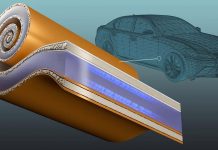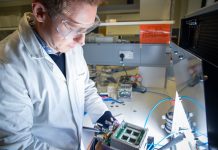
Did you know our own body can teach us ways to make better solar energy devices?
Scientists at Penn State University looked at our body’s cells and used a smart trick from them to boost solar tech.
Every cell in our body has a protective barrier called a ‘cell membrane’. Inspired by this, scientists thought, “Why not use something like that for solar devices?”
They then mixed a popular solar material called ‘perovskite’ with a lab-made version of molecules that our body produces. These molecules, like cholesterol, act like a shield since they don’t mix with water.
This special mix not only kept the solar material safe from water damage but also made it work even better. Plus, it saved on costs!
This is a big deal because perovskite is known for capturing sunlight really well. But there’s a problem: it can’t handle water. If it gets wet, it starts breaking down quickly. In the past, when scientists tried to protect it, either the cost increased or the protection made the material less effective.
Now, with this new method using body-like molecules, the solar material stays safe, works well, and doesn’t cost a fortune.
Imagine putting oil in water; they don’t mix and stay separate. Similarly, when these body molecules were added to liquid perovskite, they spread around but stayed separate.
This allowed the molecules to form a protective layer around the solar material, just like how cell membranes protect our cells.
Moreover, this combination reduced any flaws on the material’s surface that could make it less effective in capturing sunlight. The scientists tested this concept by creating solar devices about the size of two handprints.
They exposed these to the Pennsylvania weather – through rain, snow, and sunshine – for over 116 days.
The results were impressive. These solar devices performed really well, similar to the commercial ones we use today, but at a cheaper cost.
There are several reasons this breakthrough is significant. Firstly, unlike most solar materials, even as the size of the solar device using this method increases, its efficiency doesn’t decrease.
Secondly, this new addition to the solar material is natural and won’t harm the environment. We’re essentially getting cleaner energy in more ways than one. Also, since the process is cost-effective, it could be a boon for businesses. We might soon see more solar panels employing this method.
Lastly, the scientists believe that this is just the tip of the iceberg. They feel that nature has many more secrets that can be unlocked to improve technology. As one scientist put it, this is just one example of how we can learn from nature to boost our artificial devices.
In essence, by drawing inspiration from nature and our bodies, we’ve found a fantastic way to enhance solar devices. Nature continues to show us its brilliance in unexpected ways.
The study was published in the journal Advanced Energy Materials.
Follow us on Twitter for more articles about this topic.
Source: Penn State.



